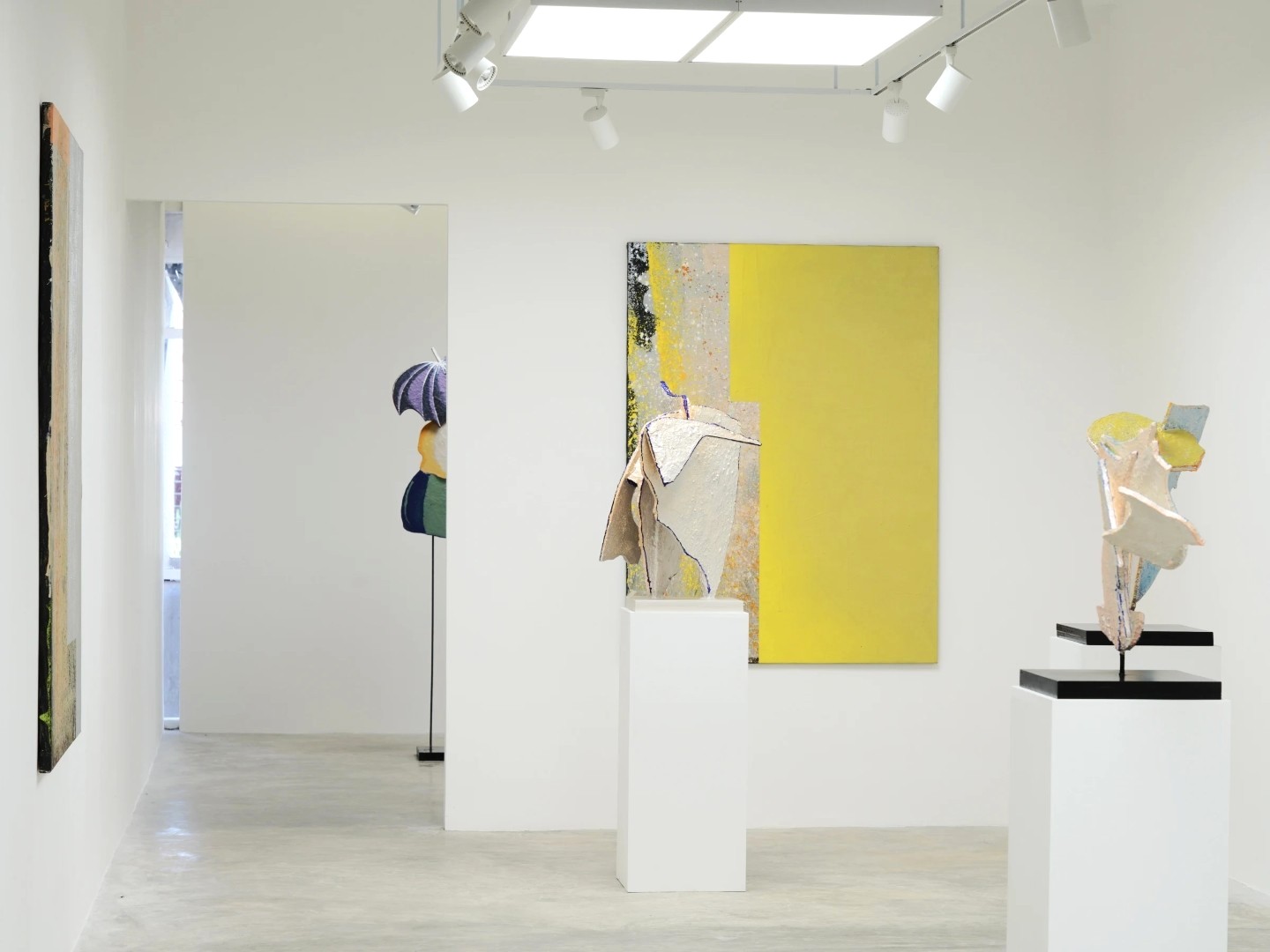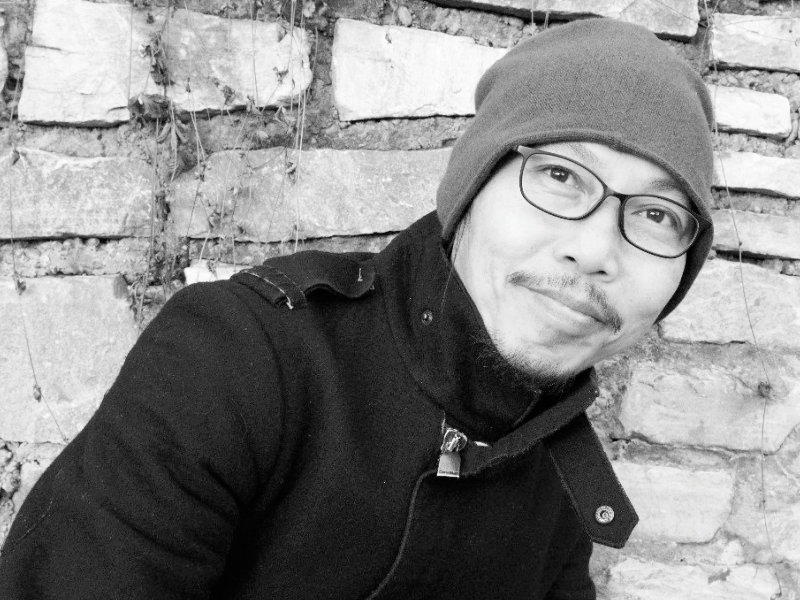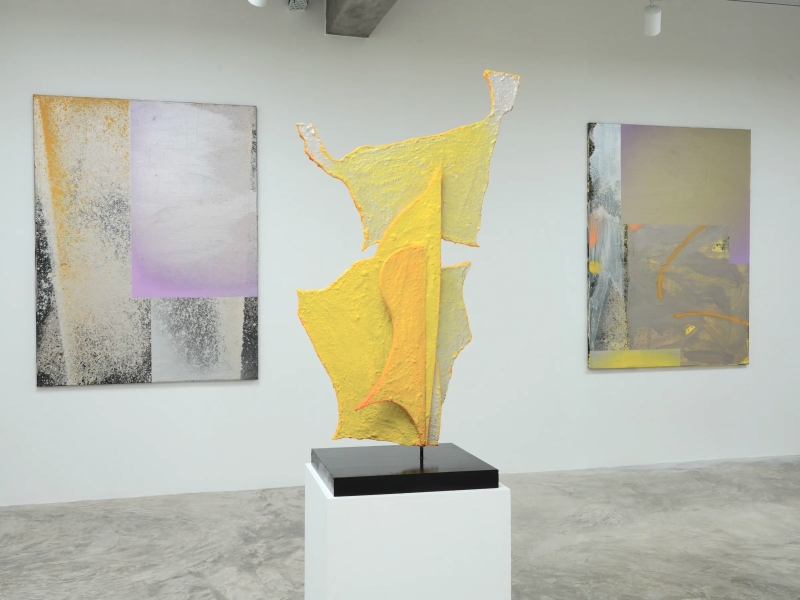
Created between Austria and Malaysia, this series weaves together painting, sculpture and a contemporary interpretation of wayang kulit (Photo: Galeri Sasha)
Options: Tell us about the evocative words you have chosen as the exhibition’s title — “being” and “here”.
Wong Perng Fey: Both words hold weight on their own but, together, they signal a quiet proposition: what does it mean to be fully present without striving to become something else? There’s a subtle reference to Martin Heidegger’s concept of Dasein or “being-there” from Being and Time. Heidegger speaks of presence not as a fixed state but a way of existing in relation to the world — embedded in time, context and perception. That idea resonates deeply with this body of work. These paintings and sculptures are not about overly emotional states or grand narratives. They hold the complexity of identity, memory and cultural tension — without needing to explain or conclude.
Being.Here reflects a shift in my mindset, especially after Beijing. It is about recognising the strange poetry of the everyday, the theatre of people in motion and the quiet clarity that comes with observing rather than asserting. It marks a moment of arrival — rooted, responsive and open.
The show comprises six paintings and 14 sculptures. What was the seed of inspiration for it?
The seed of Being.Here really came from my move to Austria. It was a kind of rupture — stepping into a slower, more ordered environment after the intensity of Beijing. I remember the transition from spring to summer that first year in Graz. There was an excitement in the light, a sense of space and a rhythm in how people moved.
Around the same time, I visited a Franz West exhibition and something shifted. His forms gave me permission to embrace awkwardness, to be playful again, to loosen the grip. It reminded me that sculpture can be direct, physical and humorous — without needing to resolve anything. That influence, combined with the environment I was living in, began to shape how I saw figures, structure and presence. For me, it usually takes about three years to develop a new visual language that feels honest — something which reflects who I am in the present, not who I was. This exhibition is the outcome of that slow unfolding. The paintings and sculptures were built in tandem, like two voices exploring the same idea from different registers.
wong_perng_fey.jpg

How would you say you have changed as an artist between Beijing and Graz?
The days in Beijing were typically busy, hectic and let me witness how a city can transform over time. Life was moving fast. It was a period of change for me, lured by the city’s promises of dreaming big while living tiny. I felt a desire to assimilate and a resistance to conformity all at the same time. This want and resistance resulted in a fragmented being.
On arriving in Graz, everyday life slowed down considerably. There are only a few neighbours in our proximity and you could say they are outnumbered by cows and donkeys. This gave me the chance to filter, to unfold the memories of the last decade. I could take the time to get used to the quietude, to learn to slow down — taking long walks, absorbing the colours of nature and the cities. The days in Graz are often a time of reflection. It takes time for things to grow, to understand the boundaries of people and places — my own even — and how far I can push them. I can now see life as a continuity of changes.
Austria, being the seat of the Habsburgs, is famously cultured. Where would you send us if we were to visit?
Vienna has an astonishing offering of cultural venues, parks and café houses. The Kunsthistorisches Museum (Vienna Museum of Art History) is a definite must-see. The wine taverns on the outskirts of the city, called heurige, are part its identity, too. Austrians are food lovers, so dinners at somebody else’s home are also a wonderful fixture of social life. Graz has, among others, the Kunsthaus Graz and also an opera. Its calendar is small compared with Vienna’s but that makes it easier to pick must-dos and not get overwhelmed.
Salzburg is a cultured crowd’s favourite but one of the best things to do there actually is simply taking a train. Going west you will see the great mountains, ideally from the comfort of a dining car with a glass of wine in hand. In winter, that means chugging through long stretches of snowy white and crystal frozen rivers. This backdrop is an essential part of the culture and where else can you find that?
dsc075421.jpg

What are you reading right now?
There are a few books on my bedside table, including Dusklands by J M Coetzee and Burma Sahib by Paul Theroux.
What are you listening to right now?
I usually paint in silence but when it suits my mood, I have a playlist of favourites that jumps rather wildly from Martha Argerich to Chinese indie bands to K-Pop.
What was your original childhood ambition?
My childhood days were spent roaming the rubber estate behind Serdang New Village in Seri Kembangan, [Selangor], swimming in the streams that ran through the woods and catching spiders and dragonflies. Back then, if you asked me about my ambition, I might have answered to fly the fastest kite or make the best lantern to parade through the village during the Mid-Autumn Festival. I was bad in school and not good at anything else, but drawing was the one activity I loved. ![]()
'Being.Here' by Wong Perng Fey is on until June 21 at Galeri Sasha, 35A, Jalan Wan Kadir 2, Taman Tun Dr Ismail, KL.
This article first appeared on June 2, 2025 in The Edge Malaysia.


